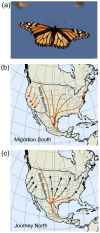Navigational mechanisms of migrating monarch butterflies
- PMID: 20627420
- PMCID: PMC2929297
- DOI: 10.1016/j.tins.2010.04.004
Navigational mechanisms of migrating monarch butterflies
Abstract
Recent studies of the iconic fall migration of monarch butterflies have illuminated the mechanisms behind their southward navigation while using a time-compensated sun compass. Skylight cues, such as the sun itself and polarized light, are processed through both eyes and are probably integrated in the brain's central complex, the presumed site of the sun compass. Time compensation is provided by circadian clocks that have a distinctive molecular mechanism and that reside in the antennae. Monarchs might also use a magnetic compass because they possess two cryptochromes that have the molecular capability for light-dependent magnetoreception. Multiple genomic approaches are now being used with the aim of identifying navigation genes. Monarch butterflies are thus emerging as an excellent model organism in which to study the molecular and neural basis of long-distance migration.
Copyright 2010 Elsevier Ltd. All rights reserved.
Conflict of interest statement
The authors declare no conflicts of interests.
Figures




References
-
- Brower LP. Understanding and misunderstanding the migration of the monarch butterfly (Nymphalidae) in North America: 1857–1995. Journal of the Lepidopterist’s Society. 1995;49:304–385.
-
- Holland RA, et al. How and why do insects migrate? Science. 2006;313:794–796. - PubMed
-
- Thorup K, Holland RA. The bird GPS - long-range navigation in migrants. Journal of Experimental Biology. 2009;212:3597–3604. - PubMed
-
- Reppert SM. A colorful model of the circadian clock. Cell. 2006;124:233–236. - PubMed
-
- Brower LP. Monarch butterfly orientation: Missing pieces of a magnificent puzzle. Journal of Experimental Biology. 1996;199:93–103. - PubMed
Publication types
MeSH terms
Substances
Grants and funding
LinkOut - more resources
Full Text Sources

